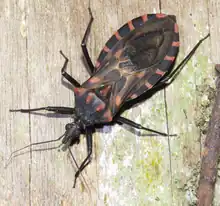| Panstrongylus megistus | |
|---|---|
 | |
| Scientific classification | |
| Domain: | Eukaryota |
| Kingdom: | Animalia |
| Phylum: | Arthropoda |
| Class: | Insecta |
| Order: | Hemiptera |
| Suborder: | Heteroptera |
| Family: | Reduviidae |
| Genus: | Panstrongylus |
| Species: | P. megistus |
| Binomial name | |
| Panstrongylus megistus Burmeister, 1835 | |
Panstrongylus megistus is a blood-drinking insect in the subfamily Triatominae. It is found in the Guianas,[1] Brazil, Bolivia, Paraguay, Uruguay and Argentina.[2] It is an important vector of Trypanosoma cruzi (the causative agent of Chagas disease),[3] found particularly in Brazil.[1] Besides humans, P. megistus is known to feed on birds, rodents, horses, dogs, opossums and bats.[2]
P. megistus is frequently found in domestic dwellings in Brazil, while in other countries it is largely a wild species.[2] Within Brazil, the P. megistus's range stretches from the northeast to the south of the country,[4] corresponding roughly with the Atlantic Forest region, though the species also occupies parts of the caatinga and cerrado ecoregions.[2] The states of Bahia and Minas Gerais have the highest populations of P. megistus in Brazil. In southern parts of the country, domestic colonization is rare.[1]
The species was described in 1835 by Hermann Burmeister, who termed it Conorhinus megistus.[5]: 130 It was identified as a vector for Chagas disease in Carlos Chagas's original 1909 description of the condition.[5]: 394 The insects are typically black in colour with red markings.[6]
References
- 1 2 3 Coura, J.R. (2015). "The main sceneries of Chagas disease transmission. The vectors, blood and oral transmissions – A comprehensive review". Memórias do Instituto Oswaldo Cruz. 110 (3): 277–282. doi:10.1590/0074-0276140362. PMC 4489464. PMID 25466622. S2CID 17867503.
- 1 2 3 4 Patterson, J. S.; Barbosa, S. E.; Feliciangeli, M. D. (2009). "On the genus Panstrongylus Berg 1879: Evolution, ecology and epidemiological significance". Acta Tropica. 110 (2–3): 187–199. doi:10.1016/j.actatropica.2008.09.008. PMID 18929527.
- ↑ Alba Soto CD, González Cappa SM (9 September 2019). "Trypanosoma cruzi Journey from the Insect Vector to the Host Cell". In Marcelo Altcheh J, Freilij H (eds.). Chagas Disease: A Clinical Approach. Birkhäuser Advances in Infectious Diseases. Switzerland: Springer Nature. pp. 25–59. doi:10.1007/978-3-030-00054-7_2. ISBN 978-3-030-00054-7. ISSN 2504-3811. S2CID 203357705.
- ↑ Barbosa, S.E.; Dujardin, J.P.; Soares, R.P.P.; Pires, H.H.R; Margonari, C.; Romanha, Á.J.; et al. (2003). "Interpopulation Variability Among Panstrongylus megistus (Hemiptera: Reduviidae) from Brazil". Journal of Medical Entomology. 40 (4): 411–420. doi:10.1603/0022-2585-40.4.411. PMID 14680104. S2CID 17722352.
- 1 2 Lent, H.; Wygodzinsky, P.W. (1979). "Revision of the Triatominae (Hemiptera, Reduviidae), and their significance as vectors of Chagas' disease". Bulletin of the American Museum of Natural History. hdl:2246/1282. ISSN 0003-0090.
- ↑ de Paiva, V.F.; Belintani, T.; de Oliviera, J.; Galvão, C.; da Rosa, J.A. (2022). "A review of the taxonomy and biology of Triatominae subspecies (Hemiptera: Reduviidae)". Parasitology Research. 121 (2): 499–512. doi:10.1007/s00436-021-07414-2. PMID 34984541. S2CID 245673495.
External links
 Media related to Panstrongylus megistus at Wikimedia Commons
Media related to Panstrongylus megistus at Wikimedia Commons